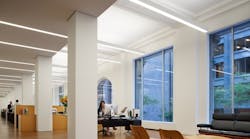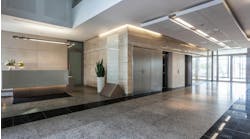It’s easy to understand how certain lighting might strain our eyes, increase our body temperature or bring a certain level of ambiance to a space. But as studies continue to show that we spend a significant portion of our lives indoors, it’s important to understand how lighting can less obviously affect our wellbeing—and, therefore, the wellbeing of your occupants.
Any lighting expert will surely know of the buzz surrounding human-centric lighting (HCL). Some consider it a fairly new technology, as much is still unknown or unproven about how it really affects human health.
Although more research on its human impacts is still needed, according to BIS Research, the global market for the technology is expected to hit $3.91 billion by 2024.
As HCL becomes more streamlined, consider what the technology is, what it’s believed to do to human health, how you can incorporate it and what you should consider before investing in the technology.
[Same topic: Tunable White Lights Can Improve Health and Well-being]
What is Human-Centric Lighting?
That can be complicated to answer, as there are many definitions of HCL out there. Brent Protzman, director of building sciences and standards development for lighting control company Lutron, says some definitions only focus on circadian rhythm (your body’s sleep/wake cycle), while others only focus on daylighting or the user experience.
A comprehensive definition of this technology needs to encompass all of these things, he says.
“What we want to make clear is human-centric lighting needs to take in all aspects of how the lighting system affects people—that could be how it affects their wellbeing, productivity or mood,” Protzman explains.
[On topic: Facts and Fiction of Tunable Lighting]
“It could be how it affects their ability to complete tasks, take ownership of their environment or their connection to the outdoors. Without considering all of that and lighting quality too, you’re not considering all things the occupant is trying to do in the space,” he continues.
Human-centric lighting, then, is a holistic approach that should include all aspects of how lighting affects occupant wellbeing, productivity and comfort in the built environment.
“Really there’s no better system to provide lighting in the space than daylight,” says Pete Shannin, vice president and general manager of Sunoptics, which focuses on skylights and daylighting systems. “But unfortunately, there are times during the day when there’s not enough daylight in the space to provide the light levels the user needs. They essentially have to turn the lights on to be able to do that.”
How HCL Affects Human Health
Also known as our sleep/wake cycle, circadian rhythm is a 24-hour internal clock that “is running in the background of your brain and cycles between sleepiness and alertness at regular intervals,” according to the National Sleep Foundation.
(Photo: Pinnacle Office, tunable white lighting. Credit: Legrand)
Circadian rhythm responds to lightness and darkness. Too much or too little exposure to certain types of light can then affect:
- Behavior
- How well we sleep at night
- Overall personal health
Paul Fritz, senior project engineer at SMP Engineering, says HCL has shown promising results in healthcare settings, such as senior care facilities.
“What some of the initial studies are showing is that if you have the ability to adjust both the intensity of the light and the color temperature during certain portions of the day, what they’re finding is the residents and patients have fewer symptoms. They have fewer trips and falls. They’re less agitated.”
Incorporating HCL Technology
(Photo: Emergent-Bio-Solutions office. Credit: Legrand)
“We’re of the opinion right now that the science is too early to be able to make that conclusion from a features or benefits perspective,” says Jared Morello, director of product management and marketing at Legrand. “There are a few important milestones we’re looking for in order to be able to start making those claims.”
But when discussing HCL technology, one new piece of tech that often comes up is tunable white lighting, which allows for the end user to adjust the intensity and color temperature of the light to mimic natural light.
Scientists agree:
Blue-white light is best for exposure during the day.
Amber light is best for exposure closer to the evening, as it’s meant to mimic the setting sun.
“What you tend to see in research is that you want that blue-white wavelength early in the morning,” Shannin explains. “During the day, that’s what’s going to help support circadian rhythm. Natural light on its own does that better than any light source. During parts of the day you want to color shift. Later in the day, daylight is no longer available. At that point, you don’t want cool white light. You want to shift from cool to warm, so you don’t suppress melatonin production.”
[Related: Harvesting Natural Light]
Tunable white lighting allows you to achieve this equilibrium – and its smart controls are a major part of that. As lighting controls become more sophisticated and automated, lighting systems have the power to become more human-centric.
That could mean something as simple as installing a wireless keypad that an end user can easily use to change the light level or shade position. Protzman says shade automation can help occupants avoid direct glare, heat gain and thermal discomfort “without having to get up from their desk and go pull a chain throughout the day.”
“There’s a misconception in the marketplace that if I just cut a hole in the roof and I bring light into the space, that’s naturally good, uniform light. That’s not the case,” says Shannin. “You’re going to get daylight, but it’s not going to be well controlled.”
What to Consider
Before you decide to invest in this technology, lighting experts say to consider these points when it comes to installing or retrofitting lighting systems that are described as human-centric.
1. Select a system that’s flexible.
“The biggest thing for facilities managers is having to live with their investment,” says Morello. “From a tenant perspective, [HCL] is going to give an additional level of flexibility. That’s the biggest thing. You can set up a schedule in the background so color will change automatically. … That takes a little bit of the workload off the end user.”
2. Select a system with a wide range of capabilities.
“When retrofitting smart lighting, facilities managers should look at future-proofing the building by selecting a system that is scalable and allows for simple configuration,” says Mark D’Ambrosio, senior project engineer for Focal Point LLC.
Adds Protzman, “As we learn more, you can adapt those systems you have and those capabilities there in place. So you don’t have to wait until next time, 15-20 years down the road, when you’re planning on doing a major retrofit. You’ve already prepared yourself for that.”
[More on this topic: Human-Centric Approach to Lighting]
3. Make sure controls are easy to use.
“Adding features that aren’t easy and intuitive for the end user could actually be a detriment,” says Protzman. “You can imagine many people have gone in to buildings or rooms they’ve never been in before and said, ‘I don’t know what to do.’ It’s a mess sometimes. It’s really important that user experience is considered as part of the design.”
4. Don’t forget about daylight.
Take advantage of all of the daylight you can get.
Learning Curve
There’s still much we don’t know about human-centric lighting and how it affects our health. However, Protzman says lighting engineers have always been lighting buildings and designing for the occupants.
“It’s not that we’ve been doing things differently,” he explains. “The good thing we have today that we didn’t have before is the technology is getting better and better. We’re adding more capabilities, and that allows us continue to do human-centric lighting in ways we haven’t been able to before.”
But when it comes to light and wellbeing, he says, “we’re still learning.”
Two handpicked articles to read next:



